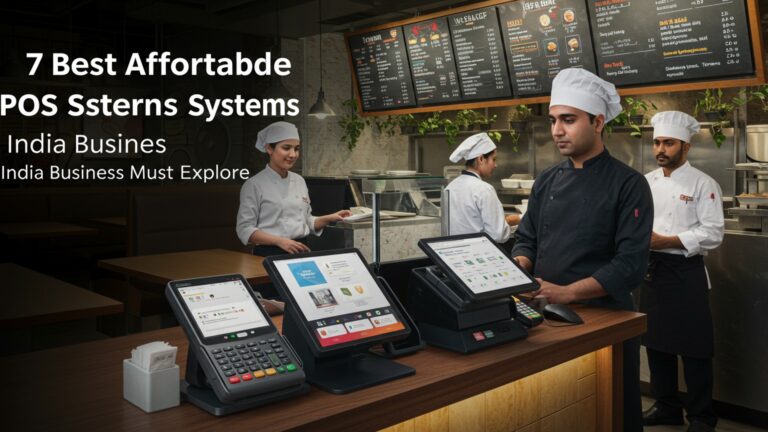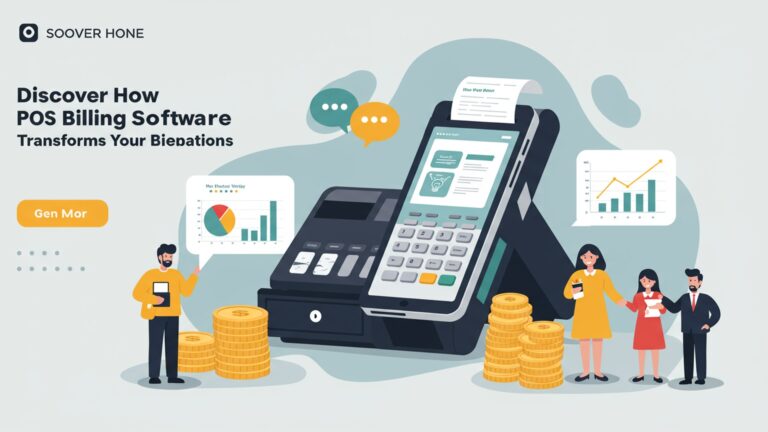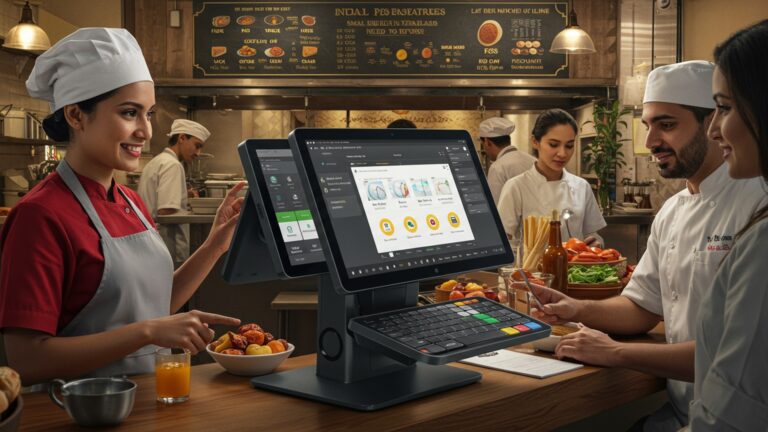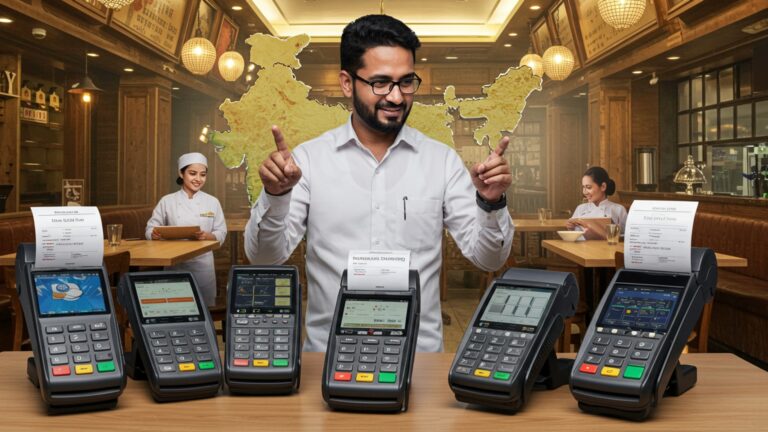7 Essential Tips to Choose the Best Restaurant POS Software in India
The dynamic Indian restaurant landscape demands more than just basic billing; it requires robust Restaurant POS software that drives efficiency and growth. With the surge in online delivery platforms like Zomato and Swiggy, coupled with the increasing adoption of QR code ordering and UPI payments, a modern POS solution in India must seamlessly integrate these critical operational facets. Choosing the right system is crucial, impacting everything from real-time inventory tracking and staff management to delivering exceptional customer experiences and actionable sales insights, transforming it into the central nervous system of your establishment.

Embrace Cloud-Based Solutions for Unmatched Flexibility
When embarking on the journey to select the optimal Restaurant POS software India, one of the foundational decisions revolves around the deployment model: cloud-based versus on-premise. A cloud-based Point of Sale (POS) system operates over the internet, storing data on remote servers rather than on local hardware. This approach has become the industry standard, offering unparalleled advantages for the dynamic Indian restaurant sector.
What is Cloud POS? A cloud POS system leverages internet connectivity to run its applications and store data. This means restaurateurs can access their system from any device, anywhere, provided they have an internet connection. This contrasts sharply with traditional on-premise systems, which require dedicated servers and software installed directly on the restaurant’s premises.
- Scalability
- Accessibility
- Cost-Effectiveness
- Data Security & Backup
- Automatic Updates
As your business grows, adding new terminals, locations, or features is seamless without significant hardware upgrades. For a multi-outlet chain or a growing single restaurant, this is a game-changer.
Manage your restaurant operations—sales, inventory, staff—from your smartphone or tablet, whether you’re at home, on vacation, or managing multiple outlets. This remote access is invaluable for busy owners.
Cloud POS typically involves a subscription model, eliminating large upfront investments in hardware and ongoing maintenance costs associated with on-premise systems. Updates are usually included and managed by the vendor.
Reputable cloud POS providers invest heavily in data security and offer automatic backups, protecting your critical business data from hardware failures, theft, or natural disasters.
Software updates, new features. security patches are rolled out automatically by the vendor, ensuring your system is always current without manual intervention.
Consider a scenario where a popular cafe in Bengaluru needs to open a new branch in Mumbai. With a cloud-based Restaurant POS software India, setting up the new outlet is as simple as installing POS terminals and logging into the existing system, with all menu items, pricing. inventory management already configured and synced.
Prioritize Seamless Integration Capabilities
The modern restaurant ecosystem is complex, involving various operational components beyond just taking orders and processing payments. The best Restaurant POS software India acts as the central nervous system. its ability to integrate with other critical tools is paramount. Look for a POS system that offers robust integration with third-party applications.
- Payment Gateways
- Online Ordering Platforms
- Inventory Management
- Customer Relationship Management (CRM)
- Accounting Software
- Staff Management/HR
Essential for processing various payment methods, including UPI, credit/debit cards, mobile wallets. QR codes, which are widely used in India. Ensure it supports popular providers like Razorpay, PayU. local bank gateways.
Integration with food aggregators like Swiggy, Zomato. your own direct online ordering system streamlines order flow, reduces manual entry errors. ensures menu consistency.
While many POS systems have built-in inventory, deep integration with specialized inventory software can provide more granular control, recipe costing. supplier management.
Connecting your POS to a CRM helps track customer preferences, loyalty programs, feedback. targeted marketing campaigns.
Seamless integration with platforms like Tally, QuickBooks, or Zoho Books simplifies financial reconciliation, tax reporting. overall bookkeeping, saving significant time and reducing errors.
Integration with payroll and attendance systems can automate wage calculations and track employee performance.
A fine-dining restaurant in Delhi uses a POS that integrates with its online reservation system, allowing staff to view table availability and customer notes directly from the POS interface. This enhances the guest experience by providing a personalized service from arrival.
Evaluate User Interface (UI) and Ease of Use
A powerful Restaurant POS software India is only effective if your staff can use it efficiently. The user interface (UI) and overall ease of use are critical factors that directly impact operational speed, training time. staff satisfaction. An intuitive system reduces order errors, speeds up service. minimizes training overhead.
- Intuitive Design
- Customization
- Language Support
- Offline Mode
- Speed and Responsiveness
The interface should be clean, logical. easy to navigate, even for new hires with minimal technical experience. Buttons should be clearly labeled. common actions should require minimal taps.
The ability to customize menu layouts, order screens. hotkeys to match your restaurant’s specific workflow can significantly improve efficiency. For instance, frequently ordered items should be easily accessible.
Given India’s linguistic diversity, consider if the POS offers multi-language support, especially if your staff communicates in regional languages.
In areas with unreliable internet, an offline mode that allows continued operation and data syncing once connectivity is restored is a lifesaver.
The system should be fast and responsive, especially during peak hours, to prevent bottlenecks at the counter or tableside.
Request a live demo and, more importantly, a free trial period. Let your actual staff—from servers to kitchen managers—test the system. Observe how quickly they pick it up and identify any friction points. A POS that requires extensive training can lead to frustration and slower service.
Assess Robust Inventory and Menu Management Capabilities
Effective inventory and menu management are the backbone of a profitable restaurant. The right Restaurant POS software India should offer comprehensive tools to manage everything from raw ingredients to complex dishes, ensuring waste reduction and consistent profitability.
- Ingredient-Level Tracking
- Variant and Modifier Management
- Supplier Management
- Waste Management
- Real-time Stock Alerts
- Menu Engineering
The system should allow you to define recipes with specific ingredient quantities. When a dish is sold, the corresponding ingredients should be automatically deducted from inventory. This is crucial for accurate costing and preventing stockouts.
Restaurants often offer customizations (e. g. , “extra cheese,” “less spicy”). The POS should handle these modifiers seamlessly, impacting pricing and ingredient tracking appropriately.
Track supplier insights, purchase orders. receiving goods directly within the POS. This helps manage vendor relationships and ensures timely restocking.
Tools to record and track food waste help identify areas for improvement and reduce costs.
Receive notifications when ingredient levels fall below predefined thresholds, prompting timely reorders.
examine sales data to identify best-selling and most profitable items, helping you optimize your menu for maximum revenue.
A popular chain of pizza outlets in Mumbai implemented a POS with advanced inventory features. By accurately tracking cheese, dough. topping consumption per pizza sold, they reduced their ingredient waste by 15% and improved their profit margins significantly over six months. This granular control is a distinguishing feature of superior Restaurant POS software India.
Demand Comprehensive Reporting and Analytics
Data is the new currency. for restaurants, insightful data can drive strategic decisions. A top-tier Restaurant POS software India should not merely record transactions but transform that raw data into actionable insights through robust reporting and analytics features.
- Sales Reports
- Inventory Reports
- Customer Reports
- Employee Performance Reports
- Profit and Loss (P&L) Reports
Detailed breakdown by item, category, time of day, server. payment method. interpret peak hours, popular dishes. employee performance.
Track ingredient usage, waste, stock levels. cost of goods sold (COGS). Identify slow-moving items and optimize purchasing.
review customer spending habits, loyalty program participation. visit frequency. This informs targeted marketing and personalized service.
Monitor individual server sales, tips. clock-in/out times.
Some advanced POS systems can even generate basic P&L statements, providing a quick overview of financial health.
A restaurant owner in Pune noticed through their POS sales analytics that their weekday lunch specials were underperforming. By analyzing the data, they adjusted their offerings and marketing, leading to a 20% increase in lunch sales within a month. This kind of data-driven decision-making is what sets apart the best Restaurant POS software India.
Comparison: Basic vs. Advanced Reporting
| Feature | Basic POS Reporting | Advanced POS Reporting |
|---|---|---|
| Sales Data | Total sales, itemized sales. | Sales by hour, day, server, payment type, category, discounts applied, voided items. |
| Inventory | Current stock levels. | Ingredient usage per dish, COGS, waste tracking, variance reports, purchase order history. |
| Customer Insights | Limited or none. | Loyalty program tracking, average spend, visit frequency, popular items for specific customers. |
| Employee Performance | Clock-in/out times. | Sales per server, tips collected, average order value per staff member. |
| Custom Reports | Rarely available. | Ability to create custom reports based on specific metrics and data points. |
Scrutinize Customer Support and Training Offerings
Even the most advanced Restaurant POS software India can encounter issues. When a problem arises—be it a payment gateway glitch during peak hours or a menu item not updating—reliable and responsive customer support is non-negotiable. Downtime translates directly to lost revenue and frustrated customers.
- 24/7 Availability
- Multiple Support Channels
- Local Presence and Language
- Onboarding and Training
- Service Level Agreements (SLAs)
Restaurants operate beyond typical business hours. Ensure support is available when you need it most, especially evenings and weekends.
Look for vendors offering support via phone, email, live chat. a comprehensive knowledge base or FAQs.
For the Indian market, having local support teams who interpret regional nuances and can communicate effectively in local languages (Hindi, Marathi, Tamil, etc.) can be a significant advantage.
Does the vendor offer initial setup assistance and comprehensive training for your staff? This is crucial for smooth adoption and maximizing the system’s potential. Ask about ongoing training resources like video tutorials or webinars.
comprehend the vendor’s commitment to response times and issue resolution.
A prominent cafe owner in Chennai once shared how their previous POS vendor’s support was solely based in another country, leading to significant delays due to time zone differences and language barriers. Switching to a provider with a robust local support team made an immediate positive impact on their operational continuity and peace of mind.
interpret Pricing Models and Hidden Costs
The cost of a Restaurant POS software India isn’t just the advertised monthly subscription. A thorough understanding of the pricing structure and potential hidden costs is essential for accurate budgeting and avoiding unpleasant surprises down the line.
- Subscription-Based (SaaS)
- One-Time Purchase (On-Premise)
The most common model for cloud POS. You pay a monthly or annual fee per terminal or per location. This typically includes software updates and basic support.
Less common now, this involves a large upfront cost for software licenses, plus ongoing fees for maintenance and updates.
- Setup and Installation Fees
- Hardware Costs
- Training Fees
- Integration Fees
- Payment Processing Fees
- Advanced Features
- Support Fees
Some vendors charge for initial setup, data migration, or hardware installation.
While software might be cloud-based, you’ll still need hardware (POS terminals, printers, cash drawers, card readers). Some vendors offer hardware bundles, while others require you to purchase separately.
Beyond basic onboarding, extensive or customized training might incur additional charges.
While many integrations are free, some premium integrations with specific third-party software might come with extra costs.
interpret the transaction fees charged by the POS provider or their integrated payment gateway. These can significantly impact your bottom line.
Some features, like advanced reporting, loyalty programs, or multi-location management, might be part of higher-tier plans or offered as add-ons.
While basic support is usually included, premium or 24/7 support might be an extra charge.
Always request a detailed quote that itemizes all potential costs for software, hardware, setup, training. ongoing support. Don’t hesitate to ask about any ‘hidden’ fees. Compare total cost of ownership (TCO) over 2-3 years, not just the monthly subscription, when evaluating different Restaurant POS software India options.
Conclusion
Choosing the ideal restaurant POS in India isn’t merely a purchase; it’s a strategic investment in your establishment’s future. My personal tip is to always conduct a thorough demo, not just once. twice – once with your manager and again with your frontline staff. Observe how it handles peak hour rush scenarios, like managing multiple online orders from Swiggy or Zomato alongside dine-in guests, or processing a quick UPI payment for a chai stall. The best software, like a well-oiled kitchen, seamlessly integrates these complex demands. Don’t just look for features; envision how they translate into tangible efficiency and improved customer experiences. A smart POS empowers you to adapt to evolving trends, from QR code menu scanning to comprehensive inventory management for your unique Indian spices. Embrace this decision as an opportunity to elevate your entire operation, ensuring smoother service, happier customers. ultimately, sustained growth in India’s dynamic food landscape. Make an informed choice. watch your restaurant thrive. For deeper insights into general POS selection, explore How to Select the Perfect POS Billing Software for Your Business.
More Articles
Discover 7 Essential POS Software Features for Cloud Kitchens in India
How to Select the Perfect POS Billing Software for Your Business
How to Set Up Cloud Based POS Software for Business Growth
How to Choose and Implement POS Software for Retail Success
How to Master POS Billing Software for Efficient Retail Operations
FAQs
What’s the absolute first thing I should look for when picking POS software for my restaurant in India?
Start with your core needs! Think about your restaurant’s size, type (cafe, fine dining, quick-service). specific operational challenges. A small cafe won’t need the same complex features as a multi-chain restaurant, so tailor your search to what really matters for your daily operations.
Are there any specific features that are a must-have for Indian restaurants?
Absolutely! Look for robust GST compliance, integration with common Indian payment gateways (like UPI, Paytm, PhonePe). features that handle local delivery partners if you use them. Good inventory management and kitchen display systems (KDS) are also crucial for efficiency.
How crucial is ease of use, really? I’m worried about my staff struggling.
It’s super vital! A complex system can slow down service, lead to errors. frustrate your team. Opt for intuitive, user-friendly software with a clean interface. Many providers offer demos or free trials, so you can test it out with your actual staff before committing to ensure smooth adoption.
What about customer support? Is local support in India necessary?
Definitely prioritize strong customer support, ideally with local teams in India. Time zone differences can be a nightmare if you’re dealing with issues during peak hours. Look for 24/7 support via phone, chat, or email. check their response times and reputation through reviews.
Should I go for a cloud-based POS or one installed directly on my computers?
For most modern Indian restaurants, cloud-based POS is generally recommended. It offers flexibility, remote access to data, automatic updates. often better data security with less upfront hardware cost. On-premise might be for very specific, niche needs. cloud usually provides more advantages.
What kind of pricing models should I expect. are there hidden costs to watch out for?
Most POS software in India operates on a subscription model (monthly or annual). Be wary of hidden costs! Always clarify what’s included in the package (e. g. , number of terminals, support, updates, integrations). Ask about setup fees, training costs. any additional charges for hardware or advanced modules.
My restaurant might expand in the future. Can my POS software grow with me?
Yes, scalability is key! Choose a system that can handle increased transaction volumes, additional outlets. new features as your business grows. Look for software that offers different plans or modules you can add on later without having to switch entire systems, which can be a huge hassle.






